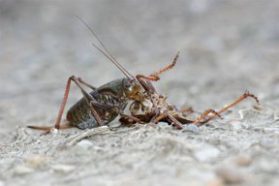Cannibal Crickets
Hunger and danger keep a certain type of cricket hopping along in large swarms.
By Emily Sohn
It sounds like the makings of a creepy movie. Swarms of insects band together and march across the landscape. They crawl over everything in their path, and they make an eerie rustling sound as they move. Along the way, they eat each other when they get the chance.
The phenomenon is strange, but true for insects known as Mormon crickets. A new set of studies offers an explanation for why it happens: These crickets go on the march when they’re short of protein and salt in their diets. As a group, they search for more nutritious pastures. Providing another convenient source of salt and protein, those crickets that can’t move as quickly as others move get eaten by their fellows.
 |
|
Mormon crickets that march in a swarm may be restoring their supplies of protein and salt when they eat laggardly swarm mates. |
| Proceedings of the National Academy of Sciences |
Mormon crickets—which are really shield-backed katydids rather than true crickets—are normally mellow creatures, each looking for food on its own. The insects can’t fly, but they can walk or hop.
Every once in a while, however, several million of the insects get together and form into a broad column that can be up to 10 kilometers long. The column then moves at a rate of about 2 kilometers per day.
Scientists suspected that the marching crickets are looking for food. To decode the behavior, the researchers first offered several varieties of dry food to swarms of crickets in the wild. Protein-rich food got the most attention, as crickets aggressively lunged and pushed to get at it. They showed no special interest in high-carbohydrate mixes.
In another test, crickets crowded around cotton wool that had been soaked in water about as salty as seawater. They liked it a lot better than they liked cotton wool soaked in plain water.
In other experiments, the crickets that could eat whatever they wanted went first for salty, protein-rich foods. After a day or two, they ate more of the carbohydrates.
It turns out that Mormon cricket bodies are actually full of salt and protein, too, which can make them an appealing snack for one another. The scientists found that crickets that didn’t move as quickly as others moved or had already died often ended up in the stomachs of their companions.
The tendency to eat slowpokes fits with complaints from western U.S. drivers, scientists say. Squashed crickets can make the roads very slippery. After a swarm begins to cross a road, cars hit a few crickets. Other crickets stop to eat the roadkill and get squashed themselves. This ends up creating a vast cricket slick.
Food cravings can be a powerful motivating force.—E. Sohn
Going Deeper:
Milius, Susan. 2006. Cannibal power: Mormon crickets swarm to eat and not be eaten. Science News 169(March 4):131-132. Available at http://www.sciencenews.org/articles/20060304/fob2.asp .
You can learn more about the Mormon cricket at www.sdvc.uwyo.edu/grasshopper/ansi.htm (University of Wyoming) and www.sidney.ars.usda.gov/grasshopper/ID_Tools/
F_Sheets/mormoncr.htm (U.S. Department of Agriculture).







